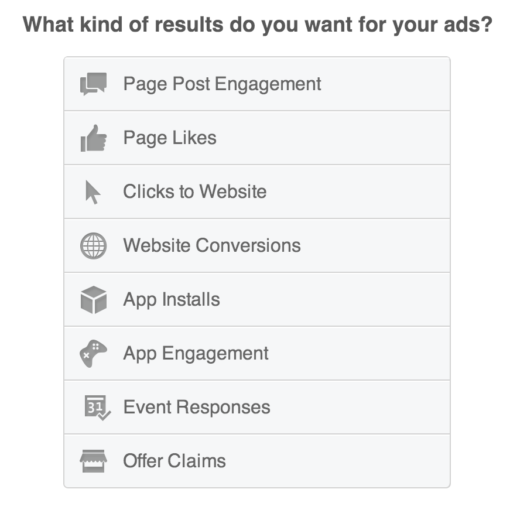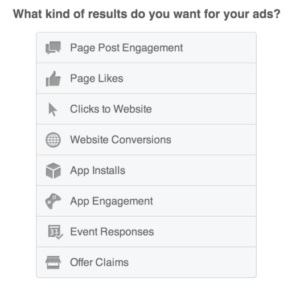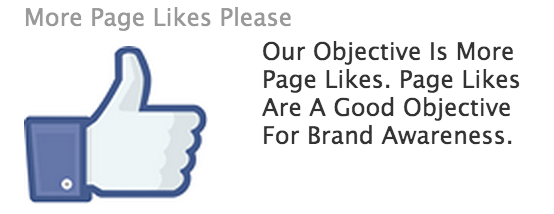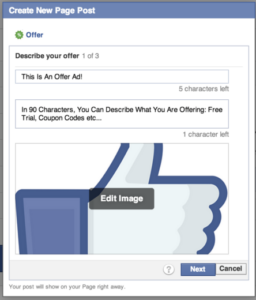Before you start any type of advertising, you should ask yourself, “What kind of results do I want for my ads?” While generally this is decided at the business level and part of the optimizations process, Facebook takes matters into their own hands and guarantees that expectations have been predetermined before the first ad is created. The first step to creating an ad on Facebook is to answer that exact question and choose an objective.
Whether you create an ad using the Power Editor or through the Facebook interface, you will have to choose one of Facebook’s eight objectives: Page Post Engagement, Page Likes, Clicks to Website, Website Conversions, App Installs, App Engagement, Event Responses and Offer Claims. Is there a best objective? No. This is something that Facebook understands correctly. Everyone has a different reason for advertising. Though I generally find more value in website conversions than page likes, if you are looking for brand awareness, those page likes might be exactly what you want. Choosing an objective should directly align with why you decided to advertise on Facebook.
What, How and Who?
I like to use the Power Editor to create ads and campaigns for time saving purposes, however, if you have never used Facebook advertising, using the ads create tool in the interface has a nice step-by-step process for ad creation. Most of the objectives are self-explanatory. For example, clicks to the website truly does mean bringing traffic to the website. However, before you decide on one objective, it is important to understand the different types and requirements necessary for each. After you choose an advertising goal, Facebook will automatically optimize your ad for the people that are most likely to complete the chosen objective.
1. Page Post Engagement: Page post engagement promotes a page post. It pursues the different variety of social engagement that Facebook offers, such as page likes, video views and comments. In order to use the page post engagement objective, you will need to have a Facebook page or place to send your traffic and have created a page post to promote. Page posts can either be an unpublished page post that is just used for advertising purposes or a regular page post that was created on your Facebook page.
2. Page Likes: Though you do not need a page post to use the page like objective, you do need a page or a place to promote. You need the traditional 25-character headline, 90-character body text and a nice image. Page likes are beneficial for branding or pursuing other types of Facebook advertising. For example, Facebook requires 50 page likes in order to use offer claims, another advertising objective. Page Likes can help you gain additional options for Facebook advertisement.
3. Clicks to Website: For website clicks, Facebook will optimize your ads for the most clicks possible. You can set it up as a page post that links to your website or a domain ad. Domain ads are useful, if you do not have a well developed Facebook page, but would still like to advertise on Facebook. Though they are limited to right side of the page and are not eligible to appear in the News Feed, it could be the best option available. This is the metric that you will use to get traffic directly to your website.
4. Website Conversions: If conversions are your goal, you have one of two different ways of pursuing conversions. If you want Facebook to optimize for conversions, the website conversion objective is similar to CPA bidding in AdWords. If you only want to bring people to your site and put trust in your landing page, clicks to website will work similarly.
5. Event Responses: As I stated earlier, Facebook isn’t trying to trick anyone with the name of their objectives and most of them are self-explanatory. Event Responses is definitely one of those. In order to create ads for an event, you will have to create an event to advertise. If your goal is get people to actually attend in person, this the type of ad objective that allows you to advertise for just that.
6. Offer Claims: Similar to offer extensions and Twitter lead cards, offer claims give an incentive to your audience to provide their email in exchange for something (whitepaper download, coupon codes, giveaways, etc.). After, an email will be sent out to your lead with directions how to claim their offer. This could be beneficial for both eCommerce and lead generation accounts. The only obstacle to offer claims is the required 50 page likes to start advertising.
There are four additional objectives available in the Facebook: App Installs, Mobile App Installs, App Engagement and Mobile App Engagement. These four objectives are only useful, if you have an app that you would like to promote. Otherwise one of the other six objectives should fit your advertising needs.








